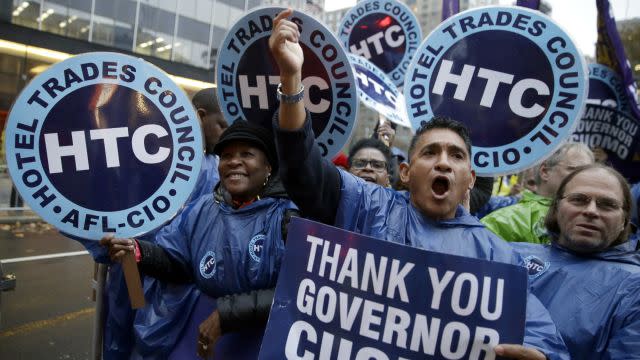Where in the US the minimum wage will rise on Jan. 1—and why it matters

On Jan. 1, minimum wage hikes will go into effect in 13 US states and several major cities, making 2016 something of a national experiment to test the effects of higher wages for the lowest-paid workers.
Economists say that higher minimum wages are an effective tool against poverty and inequality, but taken too far, they can diminish employment opportunities. Currently, the federal minimum wage is $7.25 an hour; as of this year, the highest state minimum wage is $9.32 an hour. But California and Massachusetts will soon be offering some of the highest minimum wages in the nation, at $10 an hour—while a handful of cities will be setting a $13 hourly minimum.
What happens next in these places could determine whether employee advocates succeed in their efforts to consolidate their recent gains and expand their push for a $15 national minimum wage.
Here are the state-by-state changes going into effect on Jan. 1.
State | Current | Jan. 1 | Increase |
|---|---|---|---|
Alaska | $8.75 | $9.75 | $1.00 |
Arkansas | $7.50 | $8.00 | $0.50 |
California | $9.00 | $10.00 | $1.00 |
Connecticut | $9.15 | $9.60 | $0.45 |
Hawaii | $7.75 | $8.50 | $0.75 |
Maryland | $8.00 | $8.75 | $0.75 |
Massachusetts | $9.00 | $10.00 | $1.00 |
Michigan | $8.15 | $8.50 | $0.35 |
Nebraska | $8.00 | $9.00 | $1.00 |
New York | $8.75 | $9.00 | $0.25 |
Rhode Island | $9.00 | $9.60 | $0.60 |
Vermont | $9.15 | $9.60 | $0.45 |
West Virginia | $8.00 | $8.75 | $0.75 |
Select cities will be pushing the minimum wage higher still. In Seattle, the minimum wage will rise to between $10.50 and $13, depending on the size of the company, as the city moves toward a $15 minimum wage expected to be fully implemented in 2021. In New York, fast food workers and government employees will see their minimum wage jump to $10.50 in New York City and $9.75 in the rest of the state. Come July 1, the cities of Los Angeles and San Francisco will increase their minimum wages to $10.50 and $13 an hour as they seek to eventually raise the floor on wages to $15 an hour.
The federal government estimates that about 3 million workers are paid minimum wage around the country; we can expect hundreds of thousands or more to be be affected by by next year’s increase. Critics and supporters alike will be watching to see what happens to jobs and poverty.
A 2014 study by the Congressional Budget Office found that a national minimum wage of $10.10 an hour would benefit some 16.5 million people, while leading to the elimination of 500,000 jobs due to cost-cutting offsets. The ultimate effect is still a $5 billion increase in total income for people below the poverty line, pulling some 900,000 of them over the threshold.
That is one reason why many worker advocates are urging politicians to support a national increase of $15. But Alan Krueger, the former Obama White House adviser and occasional Uber consultant who has led pioneering studies of minimum wage effects, worries that an increase to $15, while perhaps appropriate for high-priced urban areas, would be detrimental on a national level. He argues that increasing the federal floor to $12 over the next several years would be a wiser course.
Indeed, we have nearly been there before: In real terms, the minimum wage peaked around 1968, when the national minimum wage—$1.60 an hour—was worth $11.46 an hour in today’s dollars. Since then, nominal increases have been steadily eroded by inflation.
Between November 2014 and November of this year (the most recent month for which we have data) average hourly wages rose 4.3% for non-management employees, to $21.26, according to Bureau of Labor statistics data. That’s not bad, but you have to account for price inflation in the same period. At 1.1%, it reduces the average wage gain for workers to 3.2%.
While that’s still not bad news—it certainly belies my skepticism this time last year—the average worker made an inflation-adjusted $21.54 in 1973, a reminder that wage stagnation is a real thing.


Sign up for the Quartz Daily Brief, our free daily newsletter with the world’s most important and interesting news.
More stories from Quartz:
